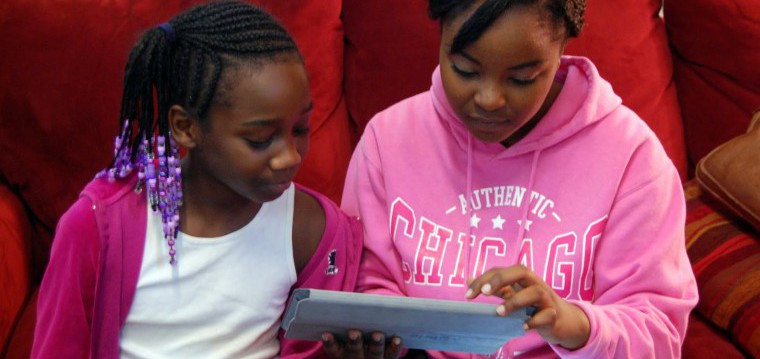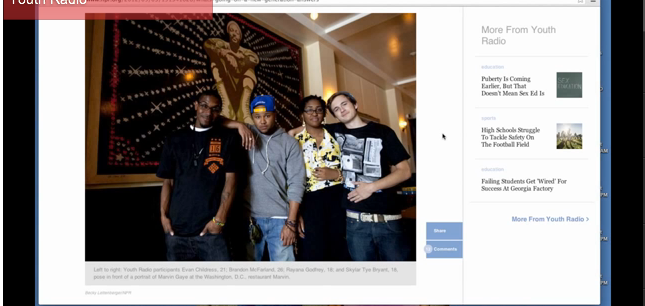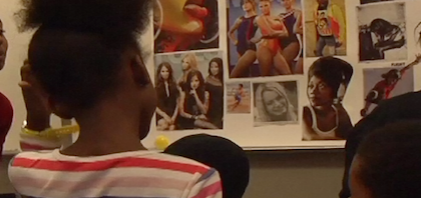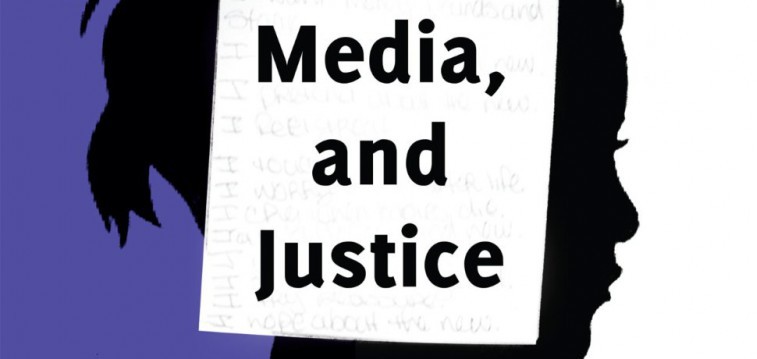Introduction
The planning of new educational institutions ought not to begin with the administrative goals of a principal or president, or with the teaching goals of a professional educator, or with the learning goals of any hypothetical class of people. It must not start with the question, ‘What should someone learn?’ but with the question, ‘What kinds of things and people might learners want to be in contact with in order to learn?’ 1
The Rondo Library is located at a busy intersection of a bustling diverse urban neighborhood in Saint Paul, Minnesota. The main floor of the library is frequently busy, crowded with people sitting quietly at tables, silently perusing aisles of books, or sitting stationary at one of thirty four computer stations. If patrons need to speak, they are encouraged by library staff to use hushed tones. However, tucked away in the back of the main floor of the Rondo Library, toward the Children’s Literature section, there is a side meeting room, and if you are lucky enough to walk by this room on a Tuesday night, you will witness adult staff and youth participating in activities that disrupt many of the typical norms of public libraries.
On this night, there are fifteen teens moving around the space, building structures with large blue and white plastic baskets, tied together with zip ties. A small group of the teens has built a cave with the baskets. One teen is crouched down, snapping photos with an iPad from inside the cave. Another is taking pictures with his cellphone and posting them on Facebook. Many of the youth laugh loudly as they scoot around the space with blue plastic baskets on their feet, as if the baskets are big shoes. At the far back table sit three teens, headphones on, playing Minecraft, an application for building digital 3D worlds on iPads. All of these teens are participating in Createch. The purpose of this Tuesday’s workshop is for teens to mess around with digital applications and participate in a group activity that involves working on building “giant” objects. They are laughing, playing, and building, immersed in creating together, while concurrently using digital technology to document and enhance their building.
Scenes like this are changing the ways that traditional public library spaces are being utilized and how learning is conceptualized. 2 Moreover, in the city of Saint Paul, Minnesota, scenes like this are changing the ways in which community organizations collaborate and the ways adult team members of these organizations participate in the creation, partnerships, and facilitation of the Createch workshops.
The Createch program began in January 2012, as a collaboration between Saint Paul Public Libraries (SPPL), the Kitty Andersen Youth Science Center (KAYSC) at the Science Museum of Minnesota, and Saint Paul Parks and Recreation (SPPR). Createch started as the Teen Tech Crew (TTC), a group of nine high school youth hired and trained by the KAYSC team and paid through the Youth Job Corps (YJC) program, a SPPR employment program for low income St. Paul youth. The TTC members worked in teams of three to create hands-on creative technology workshops at three Saint Paul Public Library sites: Rondo Library, Rice Street Teen Zone/Library, and the Arlington Library. The TTC members range in age from fifteen to nineteen, are diverse in many ways, and are from the urban neighborhoods that the Createch sites are located in. Initially, the work of the TTC began as an extension of a previous collaboration between leadership at KAYSC and SPPL, each organization bringing its own set of skills. The libraries, embedded in the community, had a deep knowledge of the community and neighborhood setting as well as relationships with community members. The KAYSC brought knowledge of informal creative technology workshops and teaching as well as a model of teens working with near-peers in workshop and outreach settings. Together, these skillsets created the opportunity for innovation and exploration and brought creative technology tools into a drop-in library context.
In the fall of 2012, SPPL and SPPR came together to implement what they were learning through the Institute of Museum and Library Services (IMLS) Learning Labs grant into their teen programming. They learned, through research of the digital inclusion movement, 3 that consistent spaces and strong mentorships were the keys to robust teen participation in digital media literacy programs. Thus, renamed as Createch, the program began providing teens from urban communities reliable access to technology and the opportunity to utilize digital media tools and learn the skills needed for full participation in digital media literacy settings.
The purposes of Createch are to provide (1) public spaces in the city for teens to access the technology needed to pursue their interests, (2) opportunities to use emerging technology to spark new passions, and (3) mentors to support teens’ individual work and growth. Currently, there are Createch spaces in three SPPL branches and one SPPR building throughout the city, and the adult team has grown to include members of the Saint Paul Neighborhood Network (SPNN), a community media center, to teach video production. The learning that takes place at Createch sites is based on the experiential learning theory HOMAGO, developed by Mizuko Ito and her team. In their paper, Living and Learning with New Media: Summary of Findings from the Digital Youth Project (2008), they describe three states of successful youth participation in digital learning spaces, hanging out, messing around, and geeking out (HOMAGO). Their work suggests that interaction with new media literacies is shifting the ways youth participate in literacy learning and that out-of-school contexts can encourage and support this participation.
What we have learned is that new media literacies and Createch spaces like the one described above are not only shifting the ways the youth participate in literacy learning but are also shifting the ways adult team leaders participate, lead, and learn. There are interesting parallels between the collaboration process of adult mentors and organizers of Createch and the HOMAGO theory of learning. 4 HOMAGO attempts to break down hierarchies of traditional learning contexts and values creativity and adaptability in learning spaces. As the youth enact HOMAGO at Createch sites to engage in new media literacies, the organizations are adapting a type of HOMAGO model in the process of their collaboration as well. Librarians are beginning to hang out with the idea of being youth workers, and youth workers are hanging out with the idea of being librarians. Administrators are messing around with the transformation of public spaces so that teens in the city can participate and learn with new media literacies–they are opening up libraries after hours and holding library programs in a teen parks and recreation department space. Adults are geeking out with these new partnerships to create positive social change. They are trusting this messy, non-linear process of learning not only for the teens, but for themselves, and because of this, HOMAGO is also changing the leadership landscape and positively impacting the success of Createch.
Below, we describe the context of each of the four Createch sites, talk about how our collaboration model “take it and make it big” came to be, and then share excerpts from a dialogue-based interview in which adult team members from each of the organizations respond to questions about their collaboration work in the program. The focus of this dialogue is on the ways in which partnering organizations are reframing how they work together and with youth. Our goal is to share some of our valuable experiences–highlights and challenges–with the rest of the youth media field so that others might learn from this evolving and adaptable HOMAGO model.
The Createch Spaces
Createch takes on a different shape, feel, and pulse in every space because each location is constructed differently by teens, mentors, neighborhood residents, and community partners. All four of the sites are vastly different because of the contextual factors that influence them. First, the Hayden Heights Createch takes place in a large meeting room with soothing colors and bamboo motifs painted on the walls. In this Createch space, though teens are still hanging out and messing around, they have the opportunity to participate in creative projects that build on each other week by week, giving them more opportunities for “geeking out.” For instance, one youth was immersed in a multi-week video poetry project. He spent a couple of weeks working hard on editing his poem, then used the program Garage Band to create a beat to accompany it. The community television organization SPNN brings in professional media and editing technologies that youth would normally not have access to in a traditional public library space.
As described in the opening vignette, The Rondo Createch site is a small meeting room located off the Children’s Literature area of the library. It is the smallest Createch space; however, the intimacy of the space has resulted in more interaction between youth and staff. In contrast, The Rice Street Teen Zone is a busy, multi-room complex. It is an institutional public city space with cinderblock walls, virtually no windows, an angular floorplan, and is leavened with comfy furniture and teen-made art. There is a robust sense of community here–many teens spend a lot of their free time at the Teen Zone. During the Createch workshops there are always other activities happening, including video game playing, teens playing pool, cooking lessons, and art activities. This presents variety but can also distract from Createch programming. The Teen Zone Createch space evolved out of a partnership between the libraries and parks and recreation department. Rather than creating a competing teen space in the neighborhood, the library chose to partner with this neighboring teens-only recreation center.
Lastly, the Arlington Hills Createch takes place in a large, multipurpose room with ten desktop computers and a very comfortable sitting area with sofas and lamps. It is a self-contained space with a great variety of resources. When librarians were hard-pressed to find space and time for teens to “hang out” in this small Carnegie library during regular hours without bothering other users (Createch was originally held concurrently with a homework center and job search assistance workshop), they started offering Createch during “Library After Dark” times. As one librarian put it, “Createch time moved after hours to give teens a place to be themselves (i.e., boisterous).” Indeed, this space houses the most “boisterous” Createch site with the youngest participants.
Take it, make it big.
The Createch name was created by the Teen Tech Crew members. When adult staff from SPPL and SPNN asked if they could use the term Createch for similar programming that did not involve the Teen Tech Crew, the response by the TTC members was, “Take it, make it big.” This attitude of collaboration has been instrumental in the success of this program. Createch is still a work in progress. It always will be. As the Youth Services Coordinator at SPPL stated, “We don’t know what it will grow into, or who will be involved in the future. We do know as staff that we need to be flexible, to adapt, and to evolve.” Just as the experiential learning theory, HOMAGO values creativity and adaptability in youth learning spaces, the HOMAGO influenced collaboration model taken up by the Createch adult team members continues to value creativity and adaptability as well.
Q & A
The excerpts below are taken from a dialogue-based interview in which adult team members from each of the organizations responded to questions about the collaboration work thus far. The participating members were: Maggie Struck (Interviewer, Createch Volunteer and Ph.D. student at the University of Minnesota), Janos MaGhie (SPPL, Librarian), Peter Kirschmann (KAYSC, Crew Manager), and Kao Choua Vue (SPNN, Youth Media Coordinator). This dialogue focused on the ways in which partnering organizations are reframing how they work together and with youth. Our goal is to share some of our valuable highlights and challenges with the rest of the youth media field in hopes that others can learn from this evolving adaptable model.
1. What were some of the challenges and surprises of adaptation of Createch?
Janos: As Createch got underway, each site identified totally different factors that were posing challenges. For example, at Arlington the space was wonderful but it was in conflict with the homework help being offered simultaneously. Rice Street library was struggling to attract teens due to the presence of an established teen rec center nearby. In resolving each site’s unique challenges, I was surprised to see how all four diverged from each other. Rice Street partnered with the recreation center to just hold Createch there, and Parks and Recreation staff came up with the idea for Arlington library to program after hours. Thus, each site developed a distinct environment and vibe, despite hosting the same initial programming.
Kao Choua: SPNN’s challenges and surprises of adapting to Createch include the process of learning about how each site and its participants are unique in their own ways. I have found that sometimes the HOMAGO style creates a more relaxed atmosphere–and that can be challenging for implementing the media production workshops. In the past, the SPNN workshops typically have taken place in a more structured environment. However, what works with Createch and SPNN is that the youth and adult facilitators have learned collectively to adapt to the environment of the particular youth space and because of this adaptability, have been able to make deep connections with youth who are interested in media production and technology skill development.
Peter: Expanding Createch to new sites and adding new partnering organizations to Createch gave the TTC youth a larger community of teen facilitators in which to share ideas. In much the same way that the adult staff from the organizations were already collaborating on creating the programming, youth from across different organizations, including youth from Minneapolis doing similar work, have been able to share skills, successes, and struggles with each other.
2. How do the entities share leadership and expertise?
Janos: Monthly meetings and staying in touch as needed through email. It’s been wonderful to have Parks & Recreation provide a trained youth developer to help staff Arlington’s site.
Kao Choua: SPNN brings a media technology production expertise which supports the purpose of Createch. SPPL and SPPR have the community spaces and connections to their patrons. We learn from each other and share our resources in order to bring the best practices in providing quality programming using the HOMAGO style workshop.
Peter: Partner organizations have regular meetings with shared facilitation to check in and reflect on the overall Createch process. Not only do these meetings give library and partner staff a chance to collaborate and share best practices, but it also provides an opportunity for library staff from across different branches to connect. Meetings often have shared facilitation between adult team members and open with a general check-in and update from all of the partners. Sometimes this is a quick overview of attendance, activities in the sites, and updates. Often times, this becomes the bulk of the meeting, sharing knowledge and information and adapting best practices which are working at one library location to work in another setting.
3. What were some of the challenges and surprises of creating intentional spaces for youth to make media?
Janos: The main challenge at my site, the Teen Zone, is that while there are lots of teens around, they have their usual activities and are hard to entice to participate in our drop-in workshops.
Kao Choua: Some challenges in creating spaces for youth to make media include the inconsistent level of involvement from partners. Libraries and recreation centers are not equipped with the latest technologies nor have the capacity of a needed media lab to support the number of youth who use the space. Also, libraries and recreation centers do not have a permanent staff with a media production background to support youth. To make Createch work, we have to have the right tools and equipment to support the youth. Furthermore, we have had to have an experienced youth media instructor on site to help facilitate student involvement and completed production. I have been surprised at how willing and flexible the other organizations have been to help us face these challenges head on–we the help of the collaboration, we are now running three Createch media production workshops at three different sites.
Peter: As Janos said, competing with other programming at sites is a continual challenge. Maintaining a consistent, regular schedule was key to helping us build an audience. As for surprises, some of the best moments at workshops were when “hanging out” with iPads were mixed with the other activities. When youth used the iPads to document their projects during a design activity, seamlessly moving from hanging out to messing around and back again.
4. How has Createch affected/supported other programming at both organizations? Are the libraries seeing better/more relationships between teens and staff? Have any Createch participants gone on to join the Set It Up crew at SPNN?
Janos: The partnership with Saint Paul Parks & Recreation has been extremely productive. It started in the Rice Street neighborhood by programming at an SPPR facility. They provided the suggestion and an extra staff member to hold Createch after hours at Arlington. We’ve also been hosting the Teen Zone youth and staff at the library for a non-Createch program once a week. Meanwhile, SPNN started as a partner exclusively for Hayden Heights library but started working with the Teen Zone and Arlington as well.
Kao Choua: Createch has bridged community outreach for SPNN in St. Paul. SPPL has completed videos and photography that show valuable connections between the community and the library. There are definitely better relationships between teens and staffers because of a dedicated teen space. There has not been any Createch participants who have joined the Set It Up crew but a few have shown an interest to join. Accessibility to the downtown space is an issue for the teens but participants have been invited to join the SPNN Open Lab on Mondays from 3-6PM where transportation is provided to Createch participants. SPNN has only been a Createch partner since March 2013, so I assume that there will continue to be an interest amongst Createch youth members to get more involved with other SPNN programs.
Peter: This has given the TTC an opportunity to share their ideas regularly in the community, and provide opportunities to try out new ideas with a set audience. Additionally, as TTC members begin to graduate from high school and move on to college and other opportunities I hope to see them working within the rec centers and libraries, to continue to support the work they began on the crew.
5. In what ways will your partnership change in the future?
Janos: Nearly all change in Createch has been in response to a specific need, a way to resolve some factor that was limiting our full potential. Thus specific changes are hard to predict until the motivating factor becomes apparent. What gives me confidence is how all of our partners have been committed to the program and will continue to work together for its total good.
Kao Choua: I believe that SPNN and SPPL’s partnership will strengthen. With SPNN’s current location at the Arlington Hills Library and developed youth relationships, we hope to be part of the new space in 2014 and bring our expertise in video production and support youth in music, journalism, and photography.
Peter: When Createch began, it consisted of TTC in the libraries every other week for a summer, quickly learning and exploring new content to bring to future workshops. Its amazing to see all of the support it is getting from library staff and through bringing in new partners, and has been great to see the scope shift. This increased support has meant that the crew has been able to spend more time contextualizing their work, exploring social and digital justice issues. This change will hopefully transform future workshops the crew leads.
Next Steps
Createch future goals include expanding the mobile lab content and including new technology such as Vinyl cutters, Makey Makey, Sphero, and 3D printing. All of the organizations are committed to continuing to train their staff and operating under the assumption that 21st century digital media skills include wearing the hat of youth worker. This fall, the library hired more youth and adult staff to support Createch workshops on the days when the TTC or SPNN staff isn’t around. They also have moved to adapting more “youth friendly” practices in these spaces such as providing snacks and offering field trips to expose youth to Createch related projects. The collaborators of Createch continue to look to the work of Ito and other library digital media programs to inform their work. They continue to strive to leverage social media practices in public settings and create intentional spaces where youth can succeed and are encouraged to not only use media but create it as well.
Bibliography
Illich, Ivan. Deschooling society. New York: Marion Boyars, 2008.
Ito, Mizuko, Heather A. Horst, Matteo Bittanti, danah boyd, Becky Herr-Stephenson, Patricia G. Lange, C.J. Pascoe, and Laura Robinson. Living and Learning with New Media: Summary of Findings from the Digital Youth Project. Chicago: The John D. and Catherine T. MacArthur Foundation Reports on Digital Media and Learning, 2008. http://digitalyouth.ischool.berkeley.edu/files/report/digitalyouth-WhitePaper.pdf.
Ito, Mizuko. Hanging Out, Messing Around, and Geeking Out: Kids Living and Learning with New Media. Boston: MIT Press, 2010.
Ito, Mizuko, Kris Gutierrez, Sonia Livingston, Bill Penuel, Jean Rhodes, Katie Salen, Juliet Schor, Julian Sefton-Green, and S. Craig Watkins. Connected Learning: An Agenda for Research and Design. Irvine, CA: Digital Media and Learning Research Hub, 2013. http://dmlhub.net/publications/connected-learning-agenda-research-and-design.
Jenkins, Henry. Confronting the Challenges of Participatory Culture: Media Education for the 21st Century. Boston: MIT Press, 2009.Pinkard, Nichole, Brigid Barron, and Caitlin Martin. Digital Youth Network: Fusing School and After-school Contexts to Develop Youth’s New Media Literacies. In Proceedings of the 8th International Conference on the Learning Sciences 3 (2008): 113-114.
Notes
- Ivan Illich, Deschooling Society, (New York: Marion Boyars, 2000), 75-76. ↩
- See Mimi Ito et al., Living and Learning with New Media: Summary of Findings from the Digital Youth Project (Chicago: John D. and Catherine T. MacArthur Foundation Reports on Digital Media and Learning, 2008); Mimi Ito, Hanging Out, Messing Around, and Geeking Out: Kids Living and Learning with New Media (Boston: MIT Press, 2010); Mimi Ito et al., Connected Learning: An Agenda for Research and Design (Irvine, CA: Digital Media and Learning Research Hub, 2013); Henry Jenkins, Confronting the Challenges of Participatory Culture: Media Education for the 21st Century (Boston: MIT Press, 2013); Nichole Pinkard et al., “Digital Youth Network: Fusing School and After-school Contexts to Develop Youth’s New Media Literacies,” in Proceedings of the 8th International Conference for the Learning Sciences, 3 (International Society of the Learning Sciences, 2008) 113-114. ↩
- See Jenkins, Confronting the Challenges; Ito, Hanging Out, 2010. ↩
- Ito, Hanging Out. ↩




